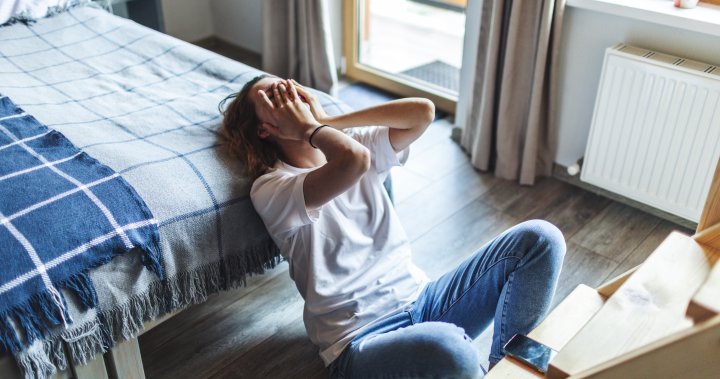Adults who live alone are more likely to grapple with higher rates of depression, especially for those lacking social and emotional support, according to a recent report.
The report, released Thursday by the United States National Center for Health Statistics (NCHS), found that 6.4 per cent of adults who lived alone reported feelings of depression, compared with 4.1 per cent who lived with others.
“People aliving alone may be at greater risk of social isolation and loneliness, which have been linked to higher mortality risk and adverse health outcomes, including mental health outcomes, compared with people living with a spouse or partner,” the authors stated in the study.
In 2021, 4.4 million Canadians lived alone, up from 1.7 million in 1981. This represented 15 per cent of all adults aged 15 and older in private households, the highest proportion on record, according to the latest data from Statistics Canada.
The continued rise of one-person households, despite the economic downturn and housing affordability issues in some areas, is almost entirely due to aging of the population, Statistics Canada said. As a result, living alone is still most prevalent at older ages.
The NCHS report found that age did matter when it came to living alone. For most age groups (30 to 44, 45 to 64, and 65 and older), adults living alone were more likely to report feelings of depression than those living with others. No significant difference was seen in the percentage of adults aged 18 to 29.
To explore a possible link between loneliness and living alone, the NCHS looked at data from a 2021 National Health Interview survey that spoke with more than 29,400 sample adults living in the U.S. This was done through phone or personal visits.
Living arrangements were defined by the number of adults and the number of children younger than age 18 living in the household. An adult was defined as living alone if one adult and no children younger than age 18 lived in the household. All other responses were categorized as living with others.
Get the latest Health IQ news.
Sent to your email, every week.
In 2021, 16 per cent of all adults were living alone in the U.S., the study said. Of all adults living alone, 39.2 per cent were age 65 or older, while 18.9 per cent of all adults living with others were 65 and older.
The report found that adults living alone reported a higher rate of limited social and emotional support (10.9 per cent), compared with just 6.1 per cent among those residing with others.
“Social and emotional support has been shown to be protective of health and this finding suggests that additional studies could examine the relationship between social and emotional support, living alone, and health outcomes,” the authors stated.
Although living alone can lead to higher rates of depression, the authors said the issue is still complex.
For example, some people may actively choose to live alone and may not experience negative effects on their physical and mental health. Meanwhile, others may live alone due to the death of a spouse or partner.
“In addition, although living alone may increase the risk of social isolation, people living alone may be actively engaged in their work or communities and may have access to social networks and social and emotional support that may be protective of mental health,” the authors added.
Living alone may also reflect better health, the study argued. People in good health may be more capable of living independently than those with worse health.
The report comes months after the World Health Organization (WHO) declared loneliness a “global public health concern.” On Nov. 16, 2023, the WHO warned loneliness could soon become a global epidemic leading to dementia, heart disease, stroke and premature death.
And in May 2023, the U.S. surgeon general warned that widespread loneliness poses health risks as deadly as smoking a dozen cigarettes daily.
In Canada, and many other countries, loneliness has long been a growing concern, but experts say the COVID-19 pandemic amplified the problem with increased social isolation and decreased social support.
One of the ways loneliness and isolation affect physical and mental health is by “altering people’s brains that contribute to disconnection,” Jake Ernst, a social worker and clinical director of Straight Up Health in Toronto, told Global News in May 2023.
“It changes our executive functioning, which happens in the front of our brain, and it actually starts to impact the way that we can connect, think, plan, organize and socially engage with other people,” Ernst explained.
This may include those who are living alone.
The 2021 report from Statistics Canada highlighted the significance of social connections for overall health, prompting concerns about the mental well-being of individuals living alone.
“The potential for experiencing social isolation may be particularly heightened among older solo-dwellers,” the report said.
With the onset of the COVID-19 pandemic, many of the opportunities for in-person social connection were removed for solo dwellers as a result of lockdowns, physical distancing, household “bubbles” and other related public health measures, Statistics Canada said.
As part of Statistics Canada’s new Quality of Life Statistics Program, it was reported that in late 2021, nearly one-quarter (24 per cent) of people living alone stated that they always or often felt lonely, more than twice the share among those living with others (11 per cent).
Those who reported frequently feeling lonely were found to report poorer mental health and lower levels of overall life satisfaction than those who were lonely less often, the report found.
— with files from Global News’ Sarah Do Couto




